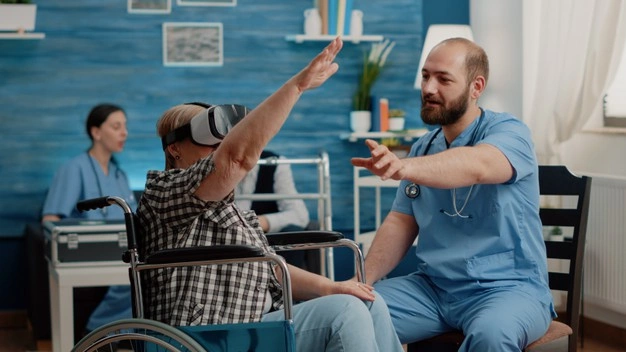Virtual reality and disability : is there a compatibility?

Presumably, you might perceive virtual reality as a simple video game support. However, in addition to witnessing unprecedented growth in the entertainment industry, VR headsets are employed in multiple fields such as education, tourism, art, and social and medical areas. More precisely and less expected, the support for people with disabilities is amongst the multiple purposes of this technology. But how? Is this device really suitable?
Virtual Reality (or VR) in a few lines
Not to be confused with augmented reality, virtual reality gives the user a dive into an artificial environment in three dimensions, which is viewable through the screen of a VR headset. This immersion occurs through hearing, seeing, and sometimes touching. Multiple features are available, from taking a simple walk through an intangible world to life or combat simulations.
The goal: Respond to the actual disability situation
According to the World Health Organization, 135 million Europeans have a form of disability, which represents 18%. Moreover, almost one-third of this percentage is exposed to a high risk of social exclusion. But over the last few years, many startups and companies have found a way to overcome this social gap in virtual reality.
The accessibility question
You will definitely notice the first issue in this approach between virtual reality and disability related to digital accessibility. From the outset, the support of this technology doesn’t seem to be adapted to all types of audiences. The user needs to make exaggerated gestures or even move in real life so that his avatar moves as well. Additionally, the VR headset involves hearing and seeing. In other words, the pre-requirements for optimal use of this device seem unavailable for the population in a situation of physical invalidity, deafness or blindness. Is it too optimistic to wish to establish a link between virtual reality and disability?
The answer is no because developers seek to optimize the accessibility of digital devices constantly . Multiple facilities aiming to adapt the virtual reality world to different forms of disability have emerged. By way of illustration, the set of tools Seeing VR of Microsoft delivers an audio description of the visuals to the weak sighted. The software WalkinVR allows, for example, to replace certain body movements with controller movements. This kind of solution enables people with reduced mobility to live beyond reach experiences in real-time, like climbing a mountain or swimming in the sea. Some improvements are still expected, but accessibility should no longer be a problem in several years by continuing on this path.
Above giving fair access to technologies, these breakthroughs can offer us a real social experience with a totally different approach. A French startup Bbird is behind Réalité, a tool for raising awareness on disability. The purpose is simple: putting non-disabled people in a disability situation thanks to virtual reality. The available simulations are dyslexia, color blindness but also autism spectrum disorder. In addition, the positive feedback shows that Bbird has well seized the critical role of empathy in human relationships.
Social inclusion: putting a price on health
The second controversial aspect is the impact of virtual reality support on health. According to doctors, their use may have a damaging effect on human beings. Indeed, visual discomfort, nausea, disorientation or even epileptic seizure represent risks linked to a too realistic brain immersion in a virtual world. Therefore, virtual reality may represent a source of additional danger for people already at risk, a counterpart that social inclusion shouldn’t have.
However, these risks can be significantly reduced by simply avoiding the overuse of VR headsets. In fact, the people suffering from disorders mentioned previously have generally used this tool excessively. The Oculus creators, or even those of HTC, recommend a 15 minutes break every half an hour of use to prevent any health consequences. If used reasonably, these devices should not represent a relevant danger.
A medical tool
Furthermore, virtual reality features real medical and therapeutic properties. For example, the research work of the company ICEBERG aims to treat paraplegia with the help of VR headsets. The rehabilitation process consists of recreating a bond between the brain and the muscles by tricking the patient’s brain thanks to a virtual reality projection of functioning members. Similarly, this technology is employed in therapy to reduce chronic pain by allowing the mind to focus on something other than suffering.
Even though some aspects are controversial, by its accessibility and awareness programs, virtual reality is compatible with disability. Moreover, it may become more critical in the medical research and treatment of infirmities and disorders. Far more than being a video game support, this technology will never cease to amaze.
This article is translated from French, read the original article here.







